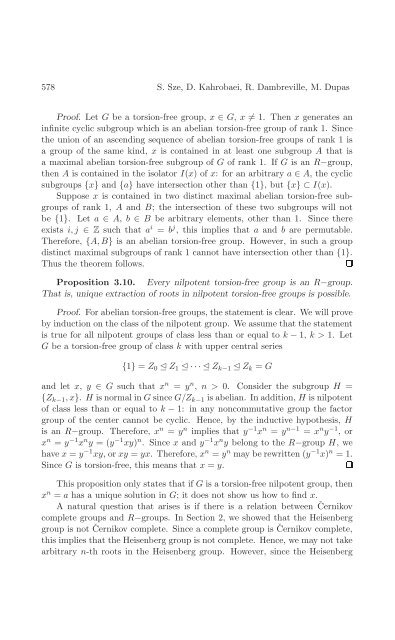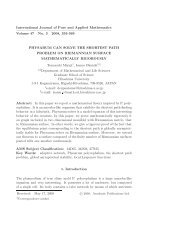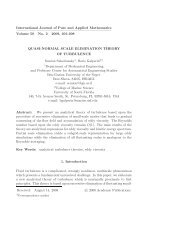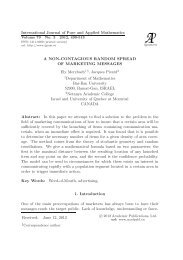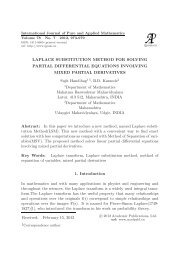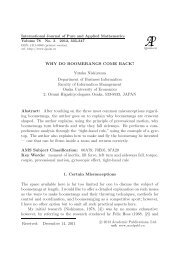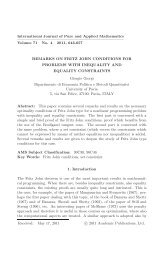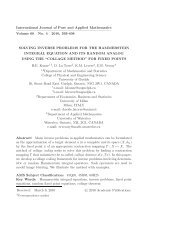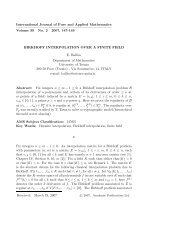FINDING N-TH ROOTS IN NILPOTENT GROUPS AND ...
FINDING N-TH ROOTS IN NILPOTENT GROUPS AND ...
FINDING N-TH ROOTS IN NILPOTENT GROUPS AND ...
Create successful ePaper yourself
Turn your PDF publications into a flip-book with our unique Google optimized e-Paper software.
578 S. Sze, D. Kahrobaei, R. Dambreville, M. Dupas<br />
Proof. Let G be a torsion-free group, x ∈ G, x = 1. Then x generates an<br />
infinite cyclic subgroup which is an abelian torsion-free group of rank 1. Since<br />
the union of an ascending sequence of abelian torsion-free groups of rank 1 is<br />
a group of the same kind, x is contained in at least one subgroup A that is<br />
a maximal abelian torsion-free subgroup of G of rank 1. If G is an R−group,<br />
then A is contained in the isolator I(x) of x: for an arbitrary a ∈ A, the cyclic<br />
subgroups {x} and {a} have intersection other than {1}, but {x} ⊂ I(x).<br />
Suppose x is contained in two distinct maximal abelian torsion-free subgroups<br />
of rank 1, A and B; the intersection of these two subgroups will not<br />
be {1}. Let a ∈ A, b ∈ B be arbitrary elements, other than 1. Since there<br />
exists i,j ∈ Z such that a i = b j , this implies that a and b are permutable.<br />
Therefore, {A,B} is an abelian torsion-free group. However, in such a group<br />
distinct maximal subgroups of rank 1 cannot have intersection other than {1}.<br />
Thus the theorem follows.<br />
Proposition 3.10. Every nilpotent torsion-free group is an R−group.<br />
That is, unique extraction of roots in nilpotent torsion-free groups is possible.<br />
Proof. For abelian torsion-free groups, the statement is clear. We will prove<br />
by induction on the class of the nilpotent group. We assume that the statement<br />
is true for all nilpotent groups of class less than or equal to k − 1, k > 1. Let<br />
G be a torsion-free group of class k with upper central series<br />
{1} = Z0 Z1 · · · Zk−1 Zk = G<br />
and let x, y ∈ G such that x n = y n , n > 0. Consider the subgroup H =<br />
{Zk−1,x}. H is normal in G since G/Zk−1 is abelian. In addition, H is nilpotent<br />
of class less than or equal to k − 1: in any noncommutative group the factor<br />
group of the center cannot be cyclic. Hence, by the inductive hypothesis, H<br />
is an R−group. Therefore, x n = y n implies that y −1 x n = y n−1 = x n y −1 , or<br />
x n = y −1 x n y = (y −1 xy) n . Since x and y −1 x n y belong to the R−group H, we<br />
have x = y −1 xy, or xy = yx. Therefore, x n = y n may be rewritten (y −1 x) n = 1.<br />
Since G is torsion-free, this means that x = y.<br />
This proposition only states that if G is a torsion-free nilpotent group, then<br />
xn = a has a unique solution in G; it does not show us how to find x.<br />
A natural question that arises is if there is a relation between Černikov<br />
complete groups and R−groups. In Section 2, we showed that the Heisenberg<br />
group is not Černikov complete. Since a complete group is Černikov complete,<br />
this implies that the Heisenberg group is not complete. Hence, we may not take<br />
arbitrary n-th roots in the Heisenberg group. However, since the Heisenberg


